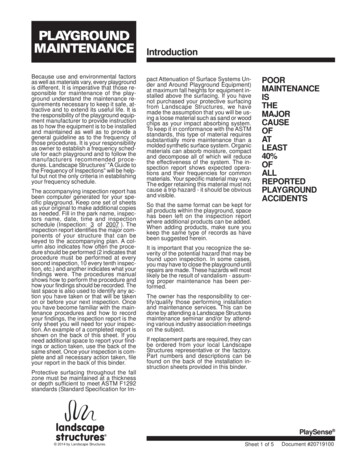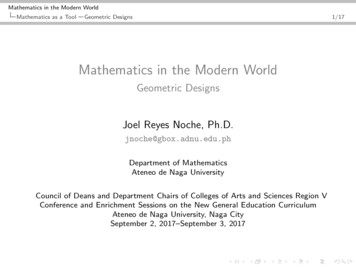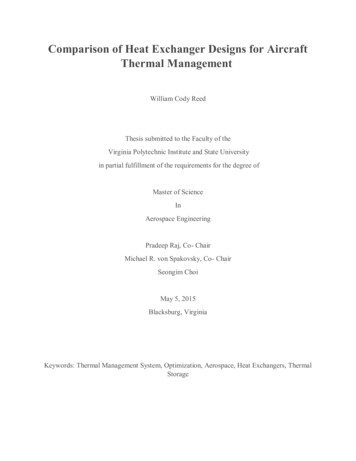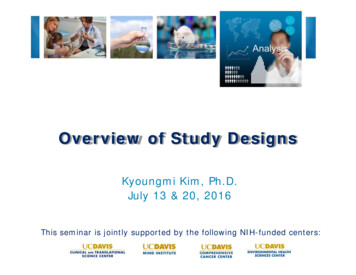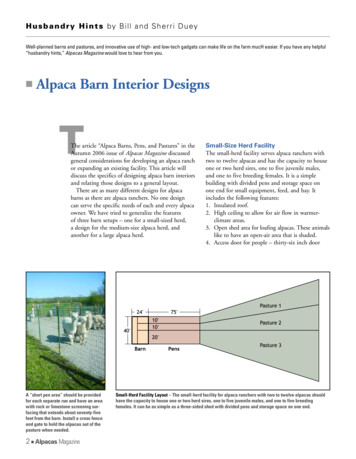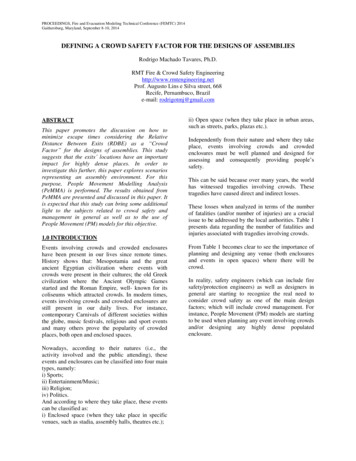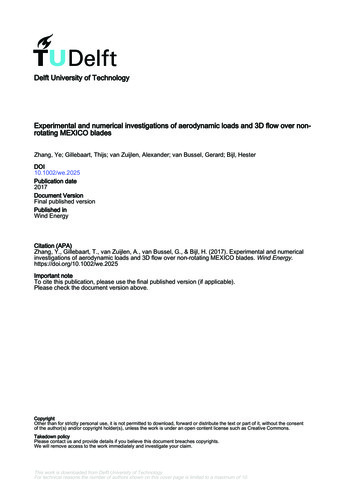
Transcription
Chapter 4Experimental Designs and Their AnalysisDesign of experiment means how to design an experiment in the sense that how the observations ormeasurements should be obtained to answer a query in a valid, efficient and economical way. The designingof the experiment and the analysis of obtained data are inseparable. If the experiment is designed properlykeeping in mind the question, then the data generated is valid and proper analysis of data provides the validstatistical inferences. If the experiment is not well designed, the validity of the statistical inferences isquestionable and may be invalid.It is important to understand first the basic terminologies used in the experimental design.Experimental unit:For conducting an experiment, the experimental material is divided into smaller parts and each part isreferred to as an experimental unit.The experimental unit is randomly assigned to treatment is theexperimental unit. The phrase “randomly assigned” is very important in this definition.Experiment:A way of getting an answer to a question which the experimenter wants to know.TreatmentDifferent objects or procedures which are to be compared in an experiment are called treatments.Sampling unit:The object that is measured in an experiment is called the sampling unit. This may be different from theexperimental unit.Factor:A factor is a variable defining a categorization. A factor can be fixed or random in nature. A factor is termedas a fixed factor if all the levels of interest are included in the experiment.A factor is termed as a random factor if all the levels of interest are not included in the experiment and thosethat are can be considered to be randomly chosen from all the levels of interest.Replication:It is the repetition of the experimental situation by replicating the experimental unit.Analysis of Variance Chapter 4 Experimental Designs & Their Analysis Shalabh, IIT Kanpur1
Experimental error:The unexplained random part of the variation in any experiment is termed as experimental error. Anestimate of experimental error can be obtained by replication.Treatment design:A treatment design is the manner in which the levels of treatments are arranged in an experiment.Example: (Ref.: Statistical Design, G. Casella, Chapman and Hall, 2008)Suppose some varieties of fish food is to be investigated on some species of fishes. The food is placed in thewater tanks containing the fishes. The response is the increase in the weight of fish. The experimental unit isthe tank, as the treatment is applied to the tank, not to the fish. Note that if the experimenter had taken thefish in hand and placed the food in the mouth of fish, then the fish would have been the experimental unit aslong as each of the fish got an independent scoop of food.Design of experiment:One of the main objectives of designing an experiment is how to verify the hypothesis in an efficient andeconomical way. In the contest of the null hypothesis of equality of several means of normal populationshaving the same variances, the analysis of variance technique can be used. Note that such techniques arebased on certain statistical assumptions. If these assumptions are violated, the outcome of the test of ahypothesis then may also be faulty and the analysis of data may be meaningless. So the main question ishow to obtain the data such that the assumptions are met and the data is readily available for the applicationof tools like analysis of variance. The designing of such a mechanism to obtain such data is achieved by thedesign of the experiment. After obtaining the sufficient experimental unit, the treatments are allocated to theexperimental units in a random fashion. Design of experiment provides a method by which the treatmentsare placed at random on the experimental units in such a way that the responses are estimated with theutmost precision possible.Principles of experimental design:There are three basic principles of design which were developed by Sir Ronald A. Fisher.(i)Randomization(ii)Replication(iii)Local controlAnalysis of Variance Chapter 4 Experimental Designs & Their Analysis Shalabh, IIT Kanpur2
(i) RandomizationThe principle of randomization involves the allocation of treatment to experimental units at random toavoid any bias in the experiment resulting from the influence of some extraneous unknown factor thatmay affect the experiment. In the development of analysis of variance, we assume that the errors arerandom and independent. In turn, the observations also become random. The principle of randomizationensures this.The random assignment of experimental units to treatments results in the following outcomes.a) It eliminates systematic bias.b) It is needed to obtain a representative sample from the population.c) It helps in distributing the unknown variation due to confounded variables throughout theexperiment and breaks the confounding influence.Randomization forms a basis of a valid experiment but replication is also needed for the validity of theexperiment.If the randomization process is such that every experimental unit has an equal chance of receiving eachtreatment, it is called complete randomization.(ii)Replication:In the replication principle, any treatment is repeated a number of times to obtain a valid and morereliable estimate than which is possible with one observation only. Replication provides an efficient wayof increasing the precision of an experiment. The precision increases with the increase in the number ofobservations. Replication provides more observations when the same treatment is used, so it increasesprecision. For example, if the variance of x is 2 than variance of the sample mean x based on nobservation is 2n. So as n increases, Var ( x ) decreases.(ii) Local control (error control)The replication is used with local control to reduce the experimental error. For example, if theexperimental units are divided into different groups such that they are homogeneous within the blocks,then the variation among the blocks is eliminated and ideally, the error component will contain thevariation due to the treatments only. This will, in turn, increase the efficiency.Analysis of Variance Chapter 4 Experimental Designs & Their Analysis Shalabh, IIT Kanpur3
Complete and incomplete block designs:In most of the experiments, the available experimental units are grouped into blocks having more or lessidentical characteristics to remove the blocking effect from the experimental error. Such design is termed asblock designs.The number of experimental units in a block is called the block size.Ifsize of block number of treatmentsandeach treatment in each block is randomly allocated,then it is a full replication and the design is called a complete block design.In case, the number of treatments is so large that a full replication in each block makes it too heterogeneouswith respect to the characteristic under study, then smaller but homogeneous blocks can be used. In such acase, the blocks do not contain a full replicate of the treatments. Experimental designs with blocks containingan incomplete replication of the treatments are called incomplete block designs.Completely randomized design (CRD)The CRD is the simplest design. Suppose there are v treatments to be compared. All experimental units are considered the same and no division or grouping among them exist. In CRD, the v treatments are allocated randomly to the whole set of experimental units, withoutmaking any effort to group the experimental units in any way for more homogeneity. Design is entirely flexible in the sense that any number of treatments or replications may be used. The number of replications for different treatments need not be equal and may vary from treatment totreatment depending on the knowledge (if any) on the variability of the observations on individualtreatments as well as on the accuracy required for the estimate of individual treatment effect.Example: Suppose there are 4 treatments and 20 experimental units, then-the treatment 1 is replicated, say 3 times and is given to 3 experimental units,-the treatment 2 is replicated, say 5 times and is given to 5 experimental units,-the treatment 3 is replicated, say 6 times and is given to 6 experimental units-finally, the treatment 4 is replicated [20-(6 5 3) ]6 times and is given to the remaining 6andexperimental units.Analysis of Variance Chapter 4 Experimental Designs & Their Analysis Shalabh, IIT Kanpur4
All the variability among the experimental units goes into experimented error. CRD is used when the experimental material is homogeneous. CRD is often inefficient. CRD is more useful when the experiments are conducted inside the lab. CRD is well suited for the small number of treatments and for the homogeneous experimentalmaterial.Layout of CRDFollowing steps are needed to design a CRD: Divide the entire experimental material or area into a number of experimental units, say n. Fix the number of replications for different treatments in advance (for given total number ofavailable experimental units). No local control measure is provided as such except that the error variance can be reduced bychoosing a homogeneous set of experimental units.ProcedureLet the v treatments are numbered from 1,2,.,v and ni be the number of replications required for ithvtreatment such that ni 1 i n.Select n1 units out of n units randomly and apply treatment 1 to these n1 units.(Note: This is how the randomization principle is utilized is CRD.) Select n2 units out of ( n n1 ) units randomly and apply treatment 2 to these n2 units. Continue with this procedure until all the treatments have been utilized. Generally, the equal number of treatments are allocated to all the experimental units unless nopractical limitation dictates or some treatments are more variable or/and of more interest.AnalysisThere is only one factor which is affecting the outcome – treatment effect. So the set-up of one-way analysisof variance is to be used.yij : Individual measurement of jth experimental units for ith treatment i 1,2,.,v , j 1,2,., ni .yij : Independently distributed following N ( i , 2 ) with : overall meanv n i 1ii 0. i : ith treatment effectAnalysis of Variance Chapter 4 Experimental Designs & Their Analysis Shalabh, IIT Kanpur5
H0 : 1 2 . v 0H1 : All i' s are not equal.The data set is arranged as follows:Treatments12 . vy11 y21 . yv1y12 y22 . yv 2 y1n1 y2 n2 . yvnvT1 T2 . Tvniwhere Ti yij is the treatment total due to ith effect,j 1vvniG Ti yiji 1is the grand total of all the observations.i 1 j 1In order to derive the test for H 0 , we can use either the likelihood ratio test or the principle of least squares.Since the likelihood ratio test has already been derived earlier, so we choose to demonstrate the use of theleast-squares principle.The linear model under consideration isyij i ij , i 1, 2,., v, j 1, 2,., niwhere ij ' s are identically and independently distributed random errors with mean 0 and variance 2 . Thenormality assumption of s is not needed for the estimation of parameters but will be needed for derivingthe distribution of various involved statistics and in deriving the test statistics.vLetnivniS ij2 ( yij i )2 .i 1 j 1i 1 j 1Minimizing S with respect to and i , the normal equations are obtained asv S 0 n ni i 0 i 1ni S 0 ni ni i yij i 1, 2,., v. ij 1Analysis of Variance Chapter 4 Experimental Designs & Their Analysis Shalabh, IIT Kanpur6
vSolving them using n ii 1i 0 , we get ˆ yoo ˆi yio yoowhere yio 1nini yij is the mean of observation receiving the ith treatment and yoo j 11 v ni yij is the meann i 1 j 1of all the observations.The fitted model is obtained after substituting the estimate ̂ and ˆi in the linear model. Using the fittedmodel, we can writeyij yoo ( yio yoo ) ( yij yio )or ( yij yoo ) ( yio yoo ) ( yij y ).Squaring both sides and summing over all the observation, we havevnivniv ( yij yoo )2 ni ( yio yoo )2 ( yij yio )2i 1 j 1i 1 i 1 j 1 Sum of squares Total sum Sum of squares due to treatment of squares effects due to error TSS SSTrSSE ororniv Since ( y yoo ) 0, so TSS is based on the sum of (n 1) squared quantities. The TSSiji 1 j 1carries only (n 1) degrees of freedom.v Since n (yii 1io yoo ) 0, so SSTr is based only on the sum of(v -1) squared quantities. TheSSTr carries only (v -1) degrees of freedom. Sinceni n (yi 1iij yio ) 0 for all i 1,2,.,v, so SSE is based on the sum of squaring n quantities like( yij yio ) with v constraints ni ( yj 1ij yio ) 0, So SSE carries (n – v) degrees of freedom.Using the Fisher-Cochran theorem,TSS SSTr SSEwith degrees of freedom partitioned as(n – 1) (v - 1) (n – v).Analysis of Variance Chapter 4 Experimental Designs & Their Analysis Shalabh, IIT Kanpur7
Moreover, equality in TSS SSTr SSE has to hold exactly. To ensure that the equality holds exactly, wefind one of the sums of squares through subtraction.Generally, it is recommended to find SSE bysubtraction asSSE TSS - SSTrnivTSS ( yij yio ) 2i 1 j 1niv yij2 i 1 j 1G2nwherevniG yij .i 1 j 1niSSTr ni ( yio yoo ) 2j 1 T 2 G2 i ni 1 ni vniwhere Ti yijj 12G: correction factor .nNow under H0 : 1 2 . v 0 , the model becomeYij ij ,vniand minimizing S ij2i 1 j 1with respect to gives SG 0 ˆ yoo . nThe SSE under H 0 becomesnivSSE ( yij yoo )2i 1 j 1and thus TSS SSE . This TSS under H 0 contains the variation only due to the random error whereas theearlier TSS SSTr SSE contains the variation due to treatments and errors both. The difference betweenthe two will provides the effect of treatments in t
Analysis of Variance Chapter 4 Experimental Designs & Their Analysis Shalabh, IIT Kanpur 1 Chapter 4 Experimental Designs and Their Analysis Design of experiment means how to design an experiment in the sense that how the observations or

